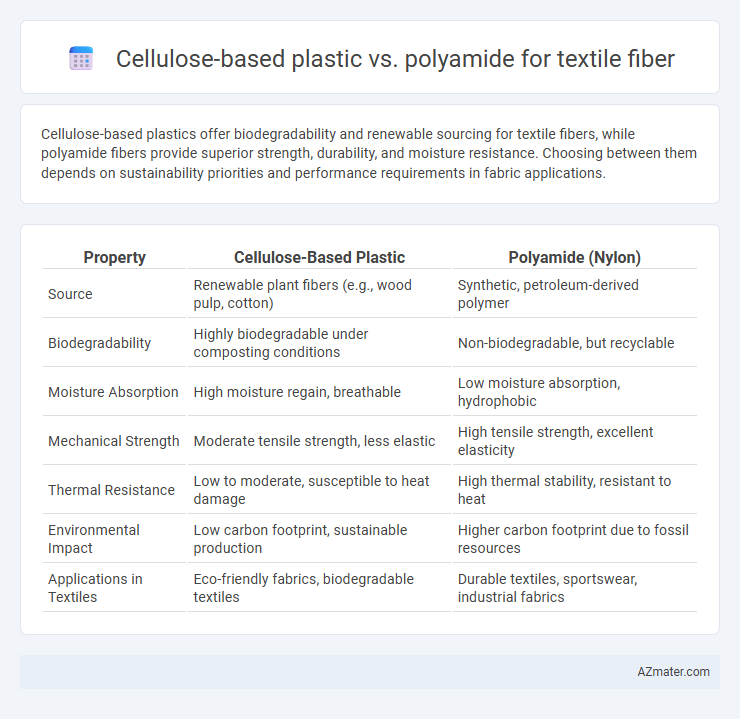Cellulose-based plastics offer biodegradability and renewable sourcing for textile fibers, while polyamide fibers provide superior strength, durability, and moisture resistance. Choosing between them depends on sustainability priorities and performance requirements in fabric applications.
Table of Comparison
| Property | Cellulose-Based Plastic | Polyamide (Nylon) |
|---|---|---|
| Source | Renewable plant fibers (e.g., wood pulp, cotton) | Synthetic, petroleum-derived polymer |
| Biodegradability | Highly biodegradable under composting conditions | Non-biodegradable, but recyclable |
| Moisture Absorption | High moisture regain, breathable | Low moisture absorption, hydrophobic |
| Mechanical Strength | Moderate tensile strength, less elastic | High tensile strength, excellent elasticity |
| Thermal Resistance | Low to moderate, susceptible to heat damage | High thermal stability, resistant to heat |
| Environmental Impact | Low carbon footprint, sustainable production | Higher carbon footprint due to fossil resources |
| Applications in Textiles | Eco-friendly fabrics, biodegradable textiles | Durable textiles, sportswear, industrial fabrics |
Introduction to Cellulose-Based Plastics and Polyamides in Textiles
Cellulose-based plastics, derived from natural polymers such as cotton and wood pulp, offer biodegradability and sustainability advantages in textile fibers. Polyamides, commonly known as nylons, are synthetic fibers characterized by high strength, elasticity, and abrasion resistance, making them suitable for durable textile applications. The choice between cellulose-based plastics and polyamides in textiles hinges on balancing environmental impact with performance requirements like moisture absorption and mechanical properties.
Material Sources: Renewable vs Synthetic Origins
Cellulose-based plastics are derived from renewable sources such as wood pulp, cotton, and other plant fibers, making them biodegradable and environmentally sustainable. Polyamide fibers, commonly known as nylon, originate from synthetic petrochemical sources, leading to higher energy consumption and non-biodegradability. The renewable origin of cellulose-based fibers offers a significant advantage in reducing carbon footprint compared to the fossil fuel-based production of polyamides.
Production Processes and Environmental Impact
Cellulose-based plastics, derived from renewable sources like wood pulp, undergo processes such as cellulose regeneration or chemical modification, which consume less energy and produce fewer greenhouse gases compared to polyamide fiber production that relies heavily on petrochemical feedstocks and energy-intensive polymerization. The biobased origin of cellulose fibers leads to enhanced biodegradability and reduced microplastic pollution, while polyamide fibers, such as nylon, persist in ecosystems and contribute to long-term environmental contamination. Lifecycle assessments reveal cellulose-based textiles exhibit a lower carbon footprint and reduced water usage, making them more sustainable alternatives in textile manufacturing.
Mechanical Properties and Durability Comparison
Cellulose-based plastics in textile fibers offer moderate tensile strength and excellent biodegradability, making them suitable for sustainable fashion applications but less resistant to prolonged mechanical stress compared to polyamide fibers. Polyamide fibers, such as nylon, exhibit superior tensile strength, abrasion resistance, and elasticity, contributing to enhanced durability and performance in demanding textile uses like sportswear and industrial fabrics. The mechanical robustness of polyamide fibers ensures greater longevity under repeated wear and environmental exposure, while cellulose fibers prioritize eco-friendly attributes with moderate mechanical resilience.
Moisture Absorption and Breathability
Cellulose-based plastics exhibit higher moisture absorption due to their hydrophilic nature, making them ideal for moisture-wicking textile fibers in activewear. Polyamide fibers, known for low moisture regain (~4%), provide excellent breathability but can trap sweat, reducing comfort during intense activities. The superior moisture management of cellulose-based fibers enhances thermal regulation and reduces odor build-up compared to polyamide textiles.
Dyeability and Color Retention
Cellulose-based plastics, such as lyocell and viscose fibers, exhibit excellent dyeability due to their hydrophilic nature, allowing for vibrant and uniform color absorption. Polyamide fibers, commonly known as nylon, offer superior color retention and resistance to fading under UV exposure and repeated washing, making them ideal for long-lasting textile applications. The choice between cellulose-based fibers and polyamides depends on the desired balance between initial dye brightness and durability of color over time.
Biodegradability and End-of-Life Options
Cellulose-based plastics exhibit superior biodegradability compared to polyamide fibers, breaking down more rapidly in natural environments due to their organic, plant-derived composition. Polyamide fibers, predominantly synthetic, present challenges in biodegradation, often persisting in landfills or requiring specialized recycling processes. End-of-life options for cellulose-based fibers include composting and bio-recycling, whereas polyamide primarily relies on mechanical recycling or energy recovery, contributing to environmental concerns over microplastic pollution.
Cost Factors and Economic Feasibility
Cellulose-based plastics, derived from renewable sources like wood pulp, generally offer lower material costs and enhanced biodegradability compared to polyamide fibers, which are petroleum-based and have higher raw material expenses. The production process for cellulose fibers involves energy-intensive steps but benefits from lower input costs and potential for sustainable supply chains, improving economic feasibility in eco-conscious markets. Polyamide fibers, while offering superior strength and durability, incur higher manufacturing and processing costs, often making cellulose-based plastics a more cost-effective and environmentally viable option for textile fiber applications.
Common Applications in the Textile Industry
Cellulose-based plastics, such as viscose and lyocell, are commonly used in textile fibers for clothing, upholstery, and industrial fabrics due to their biodegradability and moisture absorbency. Polyamide fibers, including nylon, are favored for activewear, hosiery, and outdoor textiles because of their exceptional strength, elasticity, and abrasion resistance. The textile industry leverages cellulose fibers for comfort and sustainability, while polyamides provide durability and performance in demanding applications.
Future Trends and Innovations in Textile Fibers
Cellulose-based plastics, derived from renewable resources like wood pulp, are gaining traction due to their biodegradability and reduced environmental impact compared to synthetic fibers such as polyamide, which rely on petrochemical processes. Innovations in molecular engineering are enhancing the durability and moisture management of cellulose fibers, positioning them as sustainable alternatives in performance textiles. Meanwhile, polyamide research centers on bio-based monomers and recycling technologies to lower carbon footprints while maintaining high strength and elasticity demanded in technical apparel.

Infographic: Cellulose-based plastic vs Polyamide for Textile fiber
 azmater.com
azmater.com